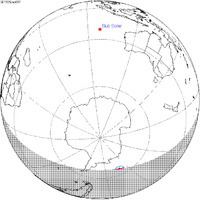Nature Partial Magnitude 0.0013 Saros 111 (79 of 79) | Gamma -1.5381 Greatest eclipse 5:35:46 Catalog # (SE5000) 9363 | |
 | ||
A partial solar eclipse occurred on January 5, 1935 during summer. A solar eclipse occurs when the Moon passes between Earth and the Sun, thereby totally or partly obscuring the image of the Sun for a viewer on Earth. A partial solar eclipse occurs in the polar regions of the Earth when the center of the Moon's shadow misses the Earth.
Contents
Description
It was one of five eclipses that took place that year, the next one was in the Northern Hemisphere on February 3 and covered much of North America.
It was the last eclipse of solar saros 111 with the moon's penumbra touching the earth for just 10 minutes. The next mini eclipse in 296 years, the last solar eclipse that was very short occurred on January 4, 1639 and had a magnitude of 0.0009 and lasted for about 7 minutes.
As is showed under 1% obscuration, the center of the Moon's shadow was missed by about 2,825 km above the area (64.7S) north of the Antarctic Circle.
The mini-eclipse took place hundreds of kilometers offshore from Antarctica in the Pacific Ocean, at the fifth minute, the greatest eclipse occurred at 5:35:45 UTC (22:45 local time) at 64.7S and 110.2 W.
As the moon moved towards the right on the Moon, in that part of Antarctica north of the South Pole at the 110th meridian west, it was seen as it was moved towards the right as the axis spinned south of 66.5 S, the Antarctic Circle.
The eclipse was the shortest in the 20th century.
Solar eclipses 1935-1938
Each member in a semester series of solar eclipses repeats approximately every 177 days and 4 hours (a semester) at alternating nodes of the Moon's orbit.
